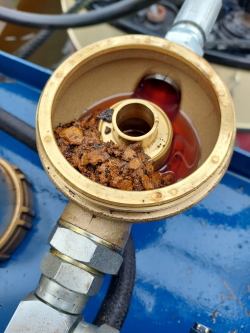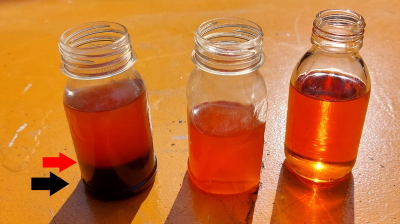Sources of Fuel Contamination

Solid Debris
Bits of dirt can enter you fuel tank in various ways - including from a contaminated supplier's tank or damaged supplier's filter, from an old fuel can used to top up to get you home, corrosion of metal work due to water in the diesel resulting in iron oxide (rust) particles forming. Filling a tank can then stir up these particles, as can boat movement in windy weather or generally rough conditions. These particles can then clog up your fuel filter. Extra fine particles can get through a fuel filter and reach the engine's injectors and damage them.
The first image here shows the solids that we trapped on the first pass of fuel from a client's tank through our equipment. Water in the fuel caused the corrosion which resulted in rust forming and flaking off the inside of the tank.
Water
Water can condense into diesel fuel tanks, due to diesel's low vapour pressure compared with petrol. When the tank warms up during the day, the air inside expands and vents, but then come night time when things cool down, damp cold air will be pulled back into the tank and condense on the cool metal surfaces. (In the case of petrol, its higher vapour pressure means less air is sucked into the tank.) Leaving the tank cap open or topping up from a fuel drum or can that has been left open also leads to water getting into the container over time.
More water is absorbed by biodiesel due to the more polar nature of the molecules. It contains fatty acid ester groups, sometimes refered to as FAMEs, short for Fatty Acid Methyl Esters, making it more hygroscopic / hydrophilic. So fuels high in biodiesel are harder to keep dry (and more difficult to dry). While there are advantages to biofuels, being a sustainable fuel with less problems when spilt or released into the environment as they are considered to be readily biodegradable, high percentage biodiesel can lead to more corrosion and more favourable conditions for the growth of micro-organisms.
Don't worry about the term Fatty Acid, the fuel contains neither fats nor acids, it's a technical term used by chemists to classify the structure of the FAMEs.
Did you know that in the aviation world, a sample of fuel is collected every day before the aircraft's first flight and inspected for water? Some people treat water in fuel very seriously. So should you.

Micro-organisms
Diesel Bug
Strange as it may seem, some micro-organisms - bacteria and fungi - can live quite happily in diesel that contains water (assuming micro-organisms actually know what being happy means). And they create a BIG problem - diesel bug sludge. These little devils live at the interface between the diesel fuel and water which, being more dense than diesel, has sunk to the bottom of the fuel tank. The bug floats there, eating the fuel. Some microbes which need oxygen to live can form on the sides of tanks. Diesel bug can be recognised as the sludge that collects on the sides and bottom of your fuel tank, and clogs up your fuel filter. Brown slimy disgusting stuff, as you can see from the image here, it will lead to all sorts of problems for your engine.
Fuel Polishing
The above contaminants are the first reason you need fuel polishing. The second reason is to avoid damaging your boat's diesel engine, diesel heating system and generator. You don't want to be stuck in some inhospitable place, waiting for a repair team to arrive, while shivering in the cold and dark, do you? Oxford Fuel Polishing Services can prevent this sort of problem. And if you do get caught out and damage your engine, our sister company, Oxford Marine Services, can help you out with repairs.

The final image shows three fuel samples - from left to right it's before polishing, after initial filtration, and fully polished. The black arrow points at the diesel bug sludge, the red arrow points at the fuel-water interface where the organisms grow.